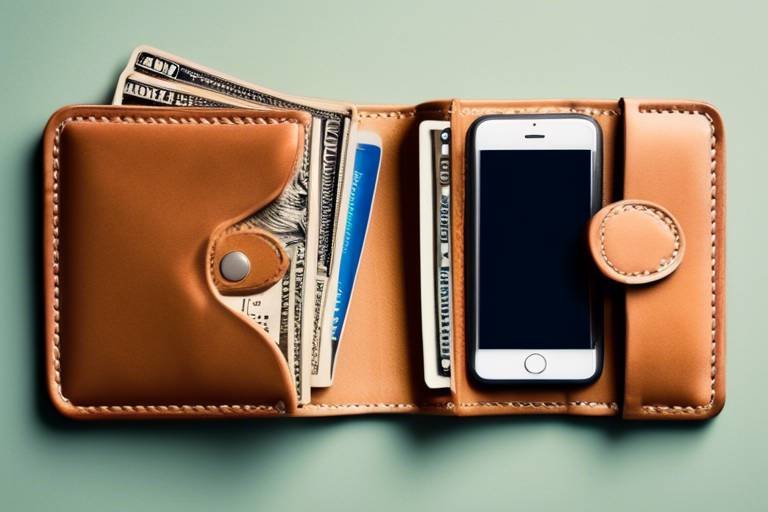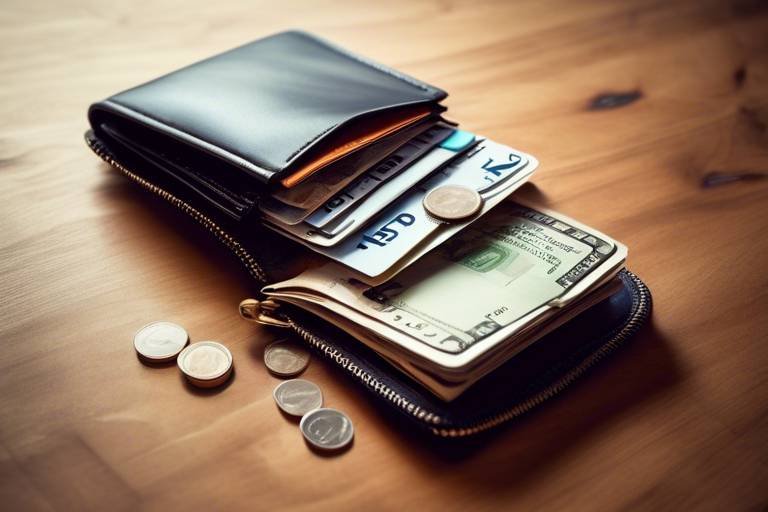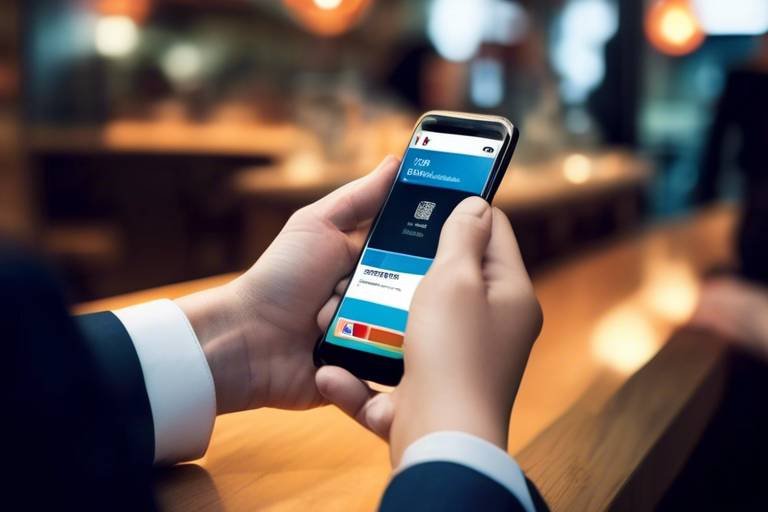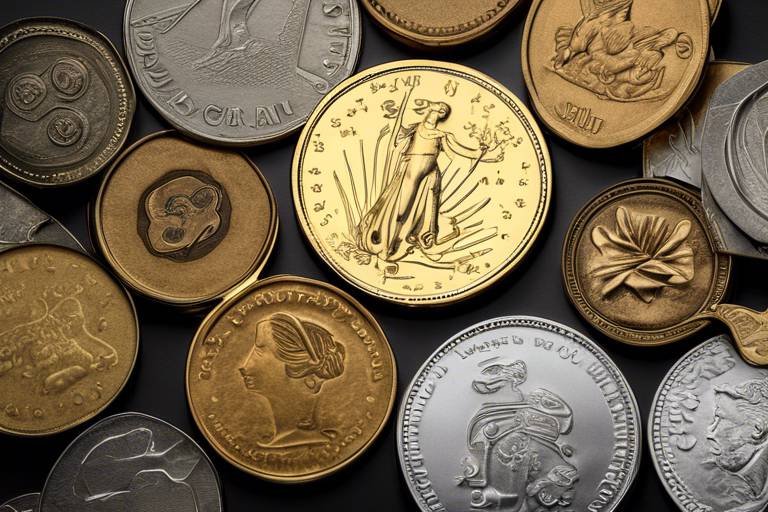Understanding the Future of Wallet Technology
In today's fast-paced digital world, the way we handle money is undergoing a remarkable transformation. Wallet technology, particularly digital wallets, is at the forefront of this revolution. Gone are the days when we relied solely on cash or physical cards to make transactions. Instead, we now have the convenience of carrying our finances in our pockets, accessible through our smartphones and smart devices. This article explores the evolving landscape of wallet technology, examining its implications for digital transactions, security, and user experience in an increasingly cashless society.
Digital wallets are not just a trend; they are becoming a fundamental part of our daily lives. Their growing popularity can be attributed to several factors that cater to the needs of modern consumers. For starters, the convenience of making purchases with just a tap or a click is hard to resist. Imagine walking into a store, grabbing what you need, and simply using your phone to pay—no cash, no cards, just your device. This ease of use appeals to a wide range of demographics, from tech-savvy millennials to busy professionals.
Moreover, the global pandemic accelerated the shift towards digital transactions. As people sought to minimize contact and enhance safety, digital wallets emerged as a preferred method for making payments. According to recent studies, the adoption of digital wallets has surged, with millions of users worldwide embracing this technology. But what drives this trend?
- Enhanced Convenience: Digital wallets allow users to store multiple payment methods in one place, making transactions faster and easier.
- Increased Security: With features like encryption and biometric authentication, digital wallets offer a level of security that traditional wallets cannot match.
- Rewards and Offers: Many digital wallets come with loyalty programs, discounts, and cashback offers that incentivize users to adopt them.
As digital wallets gain traction, security becomes paramount. Users must feel confident that their financial information is safe from fraud and cyber threats. Wallet technology has evolved to include a variety of security measures that aim to protect users. For instance, many wallets now incorporate advanced encryption techniques that safeguard sensitive data during transactions. This means that even if someone intercepts the data, it remains unreadable without the proper decryption keys.
One of the most exciting advancements in wallet security is biometric authentication. Techniques such as fingerprint scanning and facial recognition have become increasingly popular due to their effectiveness and ease of use. Imagine unlocking your wallet with just a glance or a touch—it's not only convenient but also adds a layer of security that traditional passwords simply cannot provide. User acceptance of these technologies has been generally positive, as they offer a seamless way to access financial information while keeping it secure.
However, it's not all sunshine and rainbows. Biometric systems face challenges that can impact user trust. Privacy concerns are at the forefront, as users worry about how their biometric data is stored and used. Additionally, there are potential hacking risks; if someone can replicate your fingerprint or facial features, they could gain unauthorized access to your wallet. It's essential for wallet providers to address these issues transparently to maintain user confidence.
Looking ahead, emerging technologies promise to improve biometric security in wallets. Innovations such as vein recognition and voice biometrics could provide even more secure options for users. Imagine a world where your wallet recognizes your unique vein patterns or your voice, making unauthorized access nearly impossible. These advancements could shape the future of secure digital transactions, ensuring that users can enjoy the convenience of digital wallets without compromising their security.
Encryption plays a crucial role in safeguarding wallet data. Various encryption techniques, such as symmetric and asymmetric encryption, ensure that sensitive information remains confidential. This is particularly important in maintaining user trust; after all, no one wants to risk their financial details falling into the wrong hands. Wallet providers must continually update their encryption methods to keep pace with evolving cyber threats, making it a critical aspect of wallet technology.
A seamless user experience is vital for wallet technology adoption. If a digital wallet is clunky or difficult to navigate, users will quickly lose interest. This is where design principles come into play. A well-designed interface enhances usability and accessibility for diverse user groups, ensuring that everyone—from tech novices to seasoned users—can benefit from the technology.
Personalized features in digital wallets can significantly improve user engagement. By tailoring experiences to meet individual preferences, wallet providers can enhance overall satisfaction. For example, a wallet that suggests nearby stores offering discounts or rewards based on the user's shopping habits creates a more engaging experience. It's like having a personal shopping assistant right in your pocket!
As technology evolves, so do user expectations. Future trends in wallet technology will likely focus on even more intuitive designs and features. Think about integration with augmented reality (AR) for shopping experiences or AI-driven suggestions that anticipate user needs. These innovations will not only enhance usability but also create a more immersive experience for users.
- What is a digital wallet? A digital wallet is a software application that allows users to store payment information and make transactions electronically.
- Are digital wallets safe to use? Yes, most digital wallets employ advanced security features like encryption and biometric authentication to protect user data.
- Can I use a digital wallet for online purchases? Absolutely! Digital wallets are widely accepted for both online and in-store transactions.
- What happens if I lose my phone with a digital wallet? Most digital wallets have security measures in place, such as remote locking and recovery options, to protect your information.

The Rise of Digital Wallets
In today’s fast-paced world, digital wallets are revolutionizing the way we handle transactions. Gone are the days when we relied solely on cash or credit cards; now, with just a few taps on our smartphones, we can make purchases, transfer money, and even manage our budgets. The surge in the popularity of digital wallets can be attributed to several key factors that resonate with users across various demographics. So, what exactly is driving this transformation?
One of the primary reasons for the rise of digital wallets is the **convenience** they offer. Imagine walking into a store, grabbing what you need, and checking out without fumbling through your pockets for cash or cards. With digital wallets, all your payment methods are consolidated into one app on your phone, making the checkout process not only faster but also smoother. This convenience appeals to busy professionals, tech-savvy millennials, and even older generations who are gradually embracing technology.
Another significant factor is the growing acceptance of contactless payments. As more merchants adopt NFC (Near Field Communication) technology, consumers are finding it easier to pay with their smartphones. According to recent studies, the global mobile wallet market is expected to reach a staggering $7.58 trillion by 2027, showcasing a clear trend towards cashless transactions. This shift is not just a fad; it’s becoming the norm as people increasingly prioritize speed and efficiency in their shopping experiences.
Additionally, the COVID-19 pandemic has accelerated the adoption of digital wallets. With health and safety concerns at the forefront, many consumers are opting for contactless payment methods to minimize physical interactions. This trend has prompted businesses to enhance their digital payment options, further solidifying the role of digital wallets in our daily lives. As we navigate this new normal, the demand for secure and convenient payment solutions continues to grow.
Furthermore, digital wallets often come packed with features that enhance the user experience. For instance, many wallets allow users to store loyalty cards, coupons, and even tickets, creating a one-stop-shop for all things payment-related. This integration not only simplifies transactions but also encourages users to engage more with the brands they love. Imagine having all your rewards and discounts right at your fingertips, ready to be used at checkout!
The rise of digital wallets also reflects a broader societal shift towards a cashless economy. As more people recognize the benefits of digital transactions—such as tracking spending and budgeting—traditional payment methods are gradually being phased out. This evolution is not just about technology; it’s about changing mindsets and embracing a future where cash is no longer king.
In conclusion, the ascent of digital wallets is reshaping the landscape of financial transactions. With their unmatched convenience, growing acceptance, and innovative features, these wallets are not just a passing trend—they are here to stay. As we continue to embrace this digital revolution, it’s essential to stay informed and adapt to the evolving world of wallet technology.

Security Features in Wallet Technology
As we dive deeper into the realm of digital transactions, the importance of robust security features in wallet technology cannot be overstated. With the rapid adoption of digital wallets, users are increasingly concerned about their financial safety. The surge in online transactions has attracted not only legitimate users but also cybercriminals who are always on the lookout for vulnerabilities. This makes it essential for wallet providers to implement cutting-edge security measures to protect users from fraud and cyber threats.
Among the various security features, encryption is one of the most critical components. It acts like a digital fortress, safeguarding sensitive information such as credit card details, personal identification, and transaction histories from prying eyes. The two primary types of encryption used in wallet technology are symmetric and asymmetric encryption. Each has its strengths, but both aim to ensure that data remains confidential and secure.
Furthermore, the integration of multi-factor authentication (MFA) has become a standard practice in enhancing security. MFA requires users to provide two or more verification factors to gain access to their wallets. This could include something they know (like a password), something they have (like a smartphone), or something they are (like a fingerprint). By combining these elements, the chances of unauthorized access are significantly reduced, making it a vital feature in the fight against fraud.
Additionally, digital wallets are increasingly leveraging the power of artificial intelligence (AI) to detect suspicious activities. AI algorithms can analyze transaction patterns and identify anomalies that may indicate fraudulent behavior. For instance, if a user suddenly attempts to make a large purchase in a different country, the wallet can flag this transaction for further verification. This proactive approach not only enhances security but also builds user trust in the technology.
To illustrate the various security features available in wallet technology, consider the following table:
| Security Feature | Description | Benefits |
|---|---|---|
| Encryption | Protects user data through coding techniques. | Ensures confidentiality and integrity of information. |
| Multi-Factor Authentication | Requires multiple forms of verification. | Reduces the risk of unauthorized access. |
| AI Fraud Detection | Monitors transactions for unusual patterns. | Identifies and prevents fraudulent activities. |
In conclusion, the security landscape surrounding wallet technology is continually evolving to address the growing concerns of users. With advancements in encryption, multi-factor authentication, and AI-driven fraud detection, digital wallets are becoming safer and more reliable. As we embrace a cashless society, ensuring the security of our digital transactions will be paramount, paving the way for wider adoption and trust in this innovative technology.
- What are the most common security features in digital wallets?
Common security features include encryption, multi-factor authentication, and biometric verification.
- How does biometric authentication enhance security?
Biometric authentication uses unique physical characteristics, such as fingerprints or facial recognition, making it difficult for unauthorized users to access the wallet.
- Are digital wallets safe for online transactions?
Yes, digital wallets incorporate various security measures to protect user data, but users should also practice good security habits.

Biometric Authentication
In the fast-paced world of digital transactions, has emerged as a game-changer. Imagine a world where you can make payments simply by using your fingerprint or facial recognition—sounds futuristic, right? But this technology is not just a figment of our imagination; it's already here, revolutionizing how we secure our digital wallets. With the rise of digital wallets, the need for robust security measures has never been more critical. Biometric methods enhance security by ensuring that only the authorized user can access their wallet, thereby significantly reducing the risk of fraud.
The effectiveness of biometric authentication lies in its uniqueness; no two fingerprints or facial features are alike. This is a stark contrast to traditional methods like passwords or PINs, which can be easily forgotten or stolen. According to recent studies, over 70% of consumers feel more secure using biometric methods for transactions. This growing acceptance indicates a shift in how we perceive security in the digital age. Furthermore, the convenience factor cannot be overlooked. Instead of fumbling with passwords, users can access their wallets in a matter of seconds, making the payment process smoother and more efficient.
However, while biometric authentication offers numerous advantages, it also raises questions about user acceptance and privacy. Many users are concerned about how their biometric data is stored and used. This brings us to the importance of transparency from wallet providers regarding their data handling practices. Users need to feel confident that their sensitive information is being protected, and this can only be achieved through clear communication and robust security measures.
To illustrate the current landscape of biometric authentication in wallet technology, consider the following table:
| Authentication Method | Advantages | Challenges |
|---|---|---|
| Fingerprint Recognition | Fast, unique, and widely accepted | Potential for false negatives, physical damage to sensors |
| Facial Recognition | Convenient and non-intrusive | Privacy concerns and potential for spoofing |
| Iris Scanning | Highly accurate and secure | Costly technology and user discomfort |
Despite the challenges, the future of biometric authentication in wallet technology looks promising. Innovations such as multi-factor authentication, which combines biometric data with other security measures, are on the rise. This hybrid approach not only enhances security but also addresses some of the privacy concerns users may have. As more people embrace digital wallets, the demand for secure and user-friendly authentication methods will only continue to grow.
In conclusion, biometric authentication is not just a trend; it's a pivotal element in enhancing the security of digital wallets. As we move deeper into a cashless society, the integration of biometric features will likely become the norm rather than the exception. Users must stay informed and vigilant about how their data is used, but with the right measures in place, biometric authentication can pave the way for a more secure and efficient digital payment landscape.
- What is biometric authentication? Biometric authentication uses unique physical characteristics, such as fingerprints or facial recognition, to verify a user's identity.
- Is biometric authentication secure? While it offers enhanced security compared to traditional methods, it is essential to ensure that the biometric data is stored securely and used responsibly.
- Can biometric data be hacked? Although hacking biometric systems is challenging, it is not impossible. This highlights the importance of combining biometrics with other security measures.
- What are the future trends in biometric authentication? Future trends include multi-factor authentication, advanced machine learning algorithms, and improved privacy measures to enhance user trust.

Challenges of Biometric Security
While biometric security features like fingerprint and facial recognition have revolutionized the way we authenticate ourselves in the digital realm, they are not without their challenges. One of the primary concerns is privacy. Users often worry about how their biometric data is collected, stored, and used. Unlike passwords, which can be changed, biometric data is permanent. If it gets compromised, there’s no way to reset your fingerprint or facial features. This creates a significant hurdle in building user trust.
Moreover, there are potential hacking risks. As technology advances, so do the methods employed by cybercriminals. Hackers are increasingly developing sophisticated techniques to spoof biometric systems. For instance, they might use high-resolution images to trick facial recognition systems or even 3D models to bypass fingerprint scanners. This raises the question: how secure are these systems really? The answer is complex and varies based on the technology and implementation.
Another challenge is the user acceptance of biometric security. Some individuals are hesitant to use their biometric data due to fears of surveillance or misuse. This skepticism can slow down the adoption of biometric wallets, as users may prefer traditional methods that feel more controllable. Additionally, cultural differences play a role; in some regions, people may be more open to biometric authentication than in others.
Furthermore, there are accessibility issues. Not everyone can use biometric features effectively. For example, individuals with disabilities, such as those who are visually impaired, may find it challenging to use facial recognition systems. Similarly, people with certain medical conditions might have difficulty with fingerprint scanners. This raises an important consideration for developers: how can we create inclusive biometric systems that cater to all users?
Finally, the legal landscape surrounding biometric data is still evolving. Different countries have varying regulations regarding the use and storage of biometric information. Companies must navigate these laws carefully to avoid legal repercussions, which can complicate the implementation of biometric security features.
In summary, while biometric security offers exciting possibilities for enhancing wallet technology, it also presents a series of challenges that must be addressed. From privacy concerns to accessibility issues, stakeholders must work collaboratively to create solutions that protect users while fostering trust and acceptance.
- What is biometric security? Biometric security uses unique physical characteristics, like fingerprints or facial recognition, to authenticate users.
- Are biometric systems foolproof? No, while they are more secure than traditional passwords, they are not immune to hacking and spoofing.
- How is biometric data stored? Biometric data is typically stored in a secure, encrypted format to protect it from unauthorized access.
- Can I opt-out of using biometric features? Yes, most digital wallets offer alternative authentication methods if you prefer not to use biometrics.

Future Innovations in Biometric Technology
As we gaze into the crystal ball of biometric technology, it’s clear that the future holds exciting possibilities that could revolutionize the way we secure our digital wallets. Imagine a world where your wallet is not just a tool for transactions, but a fortress of your personal data. The innovations on the horizon promise to enhance security while making the user experience even more seamless and intuitive.
One of the most promising avenues is the integration of multi-modal biometric systems. Instead of relying solely on a single biometric trait, such as a fingerprint or facial recognition, these systems combine multiple forms of identification. For instance, a user might authenticate their wallet using a combination of voice recognition, facial scans, and a fingerprint. This layered approach not only increases security but also reduces the likelihood of unauthorized access.
Furthermore, advancements in machine learning algorithms are set to enhance biometric recognition systems. These algorithms can learn from user behavior, making them more adept at distinguishing between genuine users and potential fraudsters. For example, if a user's typing pattern or the way they hold their phone changes significantly, the system could prompt for additional verification. This kind of intelligent security could provide a dynamic safeguard that evolves with the user.
Another exciting innovation is the development of wearable biometric devices. Imagine wearing a ring or a smartwatch that not only tracks your heart rate but also serves as an authentication device for your digital wallet. Such devices could utilize biometric data like heart rhythms or even body temperature, making it incredibly difficult for hackers to replicate. With wearables becoming increasingly popular, this could lead to a more integrated and user-friendly experience.
Moreover, the future might see the rise of invisible biometrics. This concept involves using biometric data that users are largely unaware of, such as behavioral biometrics that analyze patterns in how you interact with your device. For instance, the way you swipe, tap, or hold your phone could create a unique profile that serves as an additional layer of security. This kind of innovation not only enhances safety but also maintains the convenience that users crave.
In summary, the future of biometric technology in digital wallets is bright and full of potential. With innovations like multi-modal systems, machine learning enhancements, wearable devices, and invisible biometrics, we are on the brink of a new era in secure digital transactions. These advancements will not only bolster security but also create a user experience that is both personalized and fluid. As we embrace these changes, the trust in digital wallets will grow, paving the way for a more secure and cashless society.
- What are biometric wallets? Biometric wallets use unique physical characteristics, such as fingerprints or facial recognition, to authenticate users and secure transactions.
- Are biometric wallets secure? Yes, they enhance security by using unique biological traits that are difficult to replicate, but they are not immune to potential hacking.
- What is multi-modal biometric authentication? It combines multiple biometric traits to improve security, making it harder for unauthorized users to gain access.
- How do machine learning algorithms improve biometric security? They adapt to user behavior, making systems smarter and more capable of detecting anomalies that may indicate fraud.

Encryption and Data Protection
In the digital age, where every tap on your smartphone can lead to a financial transaction, encryption has become the unsung hero of wallet technology. Think of it as a secret code that keeps your sensitive information safe from prying eyes. When you make a purchase using a digital wallet, your data is transformed into a complex string of characters that only authorized parties can decode. This not only protects your financial information but also builds a layer of trust between users and service providers.
Encryption serves multiple purposes in the realm of digital wallets. Primarily, it ensures that personal data such as credit card numbers, passwords, and even biometric information remain confidential. But how does it actually work? Let’s break it down:
- Data Encryption: When you enter your details into a wallet app, the information is encrypted before it is sent over the internet. This means that even if someone intercepts the data, they won't be able to read it.
- Secure Transmission: Secure Sockets Layer (SSL) technology is often employed to create a secure connection between your device and the wallet’s server, further protecting your data during transmission.
- End-to-End Encryption: Some wallets use end-to-end encryption, meaning that only you and the recipient can access the information, ensuring that no third party can interfere.
But encryption isn't just a one-and-done solution. It requires constant updates and improvements to stay ahead of cyber threats. As hackers become more sophisticated, wallet providers must adopt advanced encryption techniques to keep users safe. For instance, many companies are now implementing AES (Advanced Encryption Standard), which is considered one of the most secure encryption methods available today. This standard has been adopted worldwide and is used by governments and financial institutions alike.
Moreover, encryption not only protects users but also enhances the overall user experience. When users know their data is secure, they are more likely to engage with digital wallets confidently. This leads to increased adoption rates and a shift away from traditional cash transactions. In fact, a recent survey indicated that over 75% of users feel more comfortable using digital wallets that employ robust encryption methods.
However, the landscape of encryption and data protection is not without its challenges. As technology evolves, so do the methods employed by cybercriminals. This cat-and-mouse game means that wallet providers must continuously innovate and adapt their security measures. The introduction of quantum computing, for example, poses a potential threat to current encryption methods, pushing the industry to explore quantum-resistant algorithms.
In conclusion, encryption is not just a technical requirement; it is a fundamental pillar that supports the entire ecosystem of digital wallets. It ensures that users can transact freely and securely, paving the way for a cashless society. As we look to the future, the focus on encryption and data protection will only intensify, making it imperative for wallet providers to stay ahead of the curve.
1. What is encryption in digital wallets?
Encryption in digital wallets is a security measure that transforms sensitive data into a coded format, making it unreadable to unauthorized users.
2. How does encryption protect my financial information?
Encryption protects your financial information by ensuring that any data transmitted over the internet is scrambled and can only be deciphered by authorized parties.
3. What are the common encryption methods used in digital wallets?
Common encryption methods include AES (Advanced Encryption Standard) and SSL (Secure Sockets Layer), which secure data during transmission.
4. Is my data safe with biometric authentication?
While biometric authentication adds an extra layer of security, it is essential to ensure that the wallet provider uses strong encryption to protect your biometric data.
5. How can I verify if my wallet uses encryption?
You can check the wallet's security features on their official website or app, looking for mentions of encryption methods like AES or SSL.

User Experience and Interface Design
The world of wallet technology is not just about functionality; it’s also about how users interact with these digital tools. A seamless user experience (UX) can make the difference between a satisfied customer and a frustrated one. Imagine trying to navigate a complex app with too many buttons and unclear options—it's like trying to find your way out of a maze without a map! That's why the design and interface of digital wallets are crucial in today’s cashless society.
To enhance usability, designers focus on creating intuitive interfaces that guide users effortlessly through their transactions. This means using clear icons, straightforward navigation, and minimizing the number of steps required to complete a payment. For instance, consider how many times you've abandoned a purchase because the payment process was too cumbersome. A well-designed wallet should feel like a trusted companion, making your life easier rather than more complicated.
Moreover, accessibility plays a significant role in user experience. Wallet technology should cater to a diverse audience, including those with disabilities. Features such as voice commands, adjustable text sizes, and color contrast settings can make a world of difference. Think of it as creating a welcoming environment where everyone feels included. When users find it easy to use a digital wallet, they are more likely to embrace it and integrate it into their daily lives.
Personalization is another key aspect of enhancing user experience. Digital wallets that adapt to individual preferences can significantly boost user engagement. For example, if a wallet app remembers your favorite payment methods or frequently used stores, it creates a more tailored experience. This can be likened to having a personal shopper who knows your tastes and preferences, making transactions smoother and more enjoyable.
As we look to the future, emerging trends in user experience design will continue to shape wallet technology. Features like augmented reality (AR) for visualizing transactions or AI-driven recommendations for spending habits could redefine how we interact with our wallets. Just imagine pointing your phone at a product and instantly receiving payment options or discounts right in your wallet app! These innovations promise to create a more engaging and efficient user experience.
| Key Elements of User Experience | Description |
|---|---|
| Intuitive Navigation | Simple and clear paths for completing transactions. |
| Accessibility Features | Options for users with disabilities, enhancing inclusivity. |
| Personalization | Tailored experiences based on user preferences and habits. |
| Future Innovations | Emerging technologies that enhance user engagement and interaction. |
In conclusion, the user experience and interface design of wallet technology are pivotal in ensuring widespread adoption and satisfaction. As digital wallets evolve, focusing on user-centric design principles will not only enhance usability but also build trust and loyalty among users. After all, in a world that’s increasingly moving towards cashless transactions, making the user feel comfortable and valued is the key to success.
- What makes a digital wallet user-friendly? A user-friendly digital wallet typically has intuitive navigation, clear icons, and minimal steps to complete transactions.
- How important is accessibility in wallet technology? Accessibility is crucial as it ensures that all users, including those with disabilities, can effectively use the wallet.
- Can personalization improve my experience with a digital wallet? Yes, personalized features can enhance user engagement by catering to individual preferences and making transactions smoother.
- What future trends should I look out for in wallet technology? Emerging trends include augmented reality features, AI-driven recommendations, and enhanced security measures.

Personalization in Wallets
In a world where everything seems to be tailored to our individual preferences, why should our digital wallets be any different? is not just a luxury; it's becoming a necessity. Imagine walking into a store and having your wallet recognize your preferences, suggesting discounts on items you frequently purchase, or even offering loyalty points just for walking in. This is the kind of experience that users are beginning to expect, and it's reshaping the way wallet technology is developed.
One of the most exciting aspects of personalization is the ability to create a unique user experience that resonates with individual needs. For instance, digital wallets can learn from your spending habits and tailor notifications about upcoming bills or reminders for subscriptions you might forget. This level of customization not only enhances user satisfaction but also fosters a deeper connection between the user and their wallet. It's like having a personal assistant right in your pocket!
Moreover, personalized features can include customizable interfaces. Users can choose themes, colors, and even the layout of their wallet apps. This customization allows users to express their individuality while using a tool that is fundamentally practical. Think of it as dressing your wallet in your favorite outfit. The more it feels like “you,” the more likely you are to use it regularly.
However, personalization goes beyond aesthetics and reminders. It also encompasses smart features that adapt to your lifestyle. For example, if you frequently travel, your wallet could automatically suggest the best currency exchange rates or notify you of transaction fees associated with foreign purchases. This kind of intelligent personalization not only saves time but also helps users make informed financial decisions.
To sum it up, the future of wallet technology is all about embracing personalization. As digital wallets continue to evolve, they are set to become more intuitive and user-friendly, catering to the unique needs of each individual. The more personalized the experience, the more users will feel empowered and satisfied with their digital transactions. And let’s face it, in today’s fast-paced world, who doesn’t want a little extra help managing their finances?
- What is personalization in digital wallets? Personalization in digital wallets refers to the customization features that allow users to tailor their wallet experience based on their preferences and habits.
- How can personalized wallets improve user experience? They can enhance user engagement by offering tailored notifications, customizable interfaces, and smart features that adapt to individual lifestyles.
- Are there any privacy concerns with personalized wallets? Yes, while personalization improves user experience, it can raise privacy concerns regarding data collection and usage. Users should always be aware of how their data is being utilized.
- What future trends can we expect in wallet personalization? Future trends may include even more advanced AI-driven features, deeper integration with other apps, and enhanced security measures to protect personalized data.

Future Trends in User Experience
As we look ahead, the landscape of digital wallets is poised for a remarkable transformation, driven by an ever-evolving understanding of user needs and technological advancements. The future trends in user experience (UX) are not just about making transactions easier; they’re about crafting an engaging, intuitive, and personalized experience that resonates with users on a deeper level. Imagine walking into a store, and your wallet instantly recognizing your preferences, suggesting the best deals, and even completing the payment with just a smile. Sounds futuristic, right? But this is the direction wallet technology is headed.
One of the most significant trends is the integration of artificial intelligence (AI) into wallet applications. AI can analyze user behavior and transaction history to offer personalized recommendations, making the shopping experience more tailored and enjoyable. For instance, if a user frequently buys coffee from a specific café, the wallet could send a notification about special promotions at that location, thereby enhancing the overall user experience.
Moreover, the rise of voice-activated transactions is also on the horizon. With the growing popularity of smart speakers and virtual assistants, users will soon be able to make payments or check their balances simply by speaking. This hands-free approach not only adds convenience but also aligns with the increasing demand for accessibility in technology. Imagine cooking in the kitchen and asking your virtual assistant to pay your utility bill while you’re busy with dinner prep!
Another captivating trend is the emphasis on seamless integration across platforms. Users are increasingly accessing their wallets from various devices, including smartphones, tablets, and wearables. As such, the future of wallet technology will likely focus on creating a unified experience that allows users to switch between devices effortlessly. This means that whether you're checking out on your phone or using your smartwatch to pay for a coffee, the experience will be consistent and fluid.
Furthermore, enhanced security features will play a crucial role in shaping user experiences. As digital wallets become more prevalent, users will demand greater peace of mind regarding their financial data. Future wallets are expected to incorporate advanced security measures, such as multi-factor authentication and real-time fraud detection, which will not only protect users but also build their trust in digital transactions.
Lastly, the concept of social payments is gaining traction. Imagine a world where splitting a bill with friends is as simple as tapping a button. Future wallet technologies are likely to incorporate social features that allow users to send and receive money effortlessly within their social networks. This could revolutionize how we think about transactions, making them more social and interactive.
In conclusion, the future of user experience in wallet technology is bright and full of possibilities. As we embrace these trends, the focus will be on creating wallets that are not only functional but also delightful to use. With AI, voice activation, seamless integration, enhanced security, and social payment features, the digital wallet of tomorrow will be an indispensable tool that fits seamlessly into our lives.
- What are digital wallets? Digital wallets are applications that allow users to store payment information and make transactions electronically using their smartphones or other devices.
- How do digital wallets enhance user experience? They offer convenience, personalization, and seamless integration across devices, making transactions faster and more intuitive.
- Are digital wallets secure? Yes, most digital wallets employ advanced security measures such as encryption, biometric authentication, and multi-factor authentication to protect user data.
- What trends can we expect in the future of wallet technology? Expect advancements in AI, voice-activated transactions, enhanced security, and social payment features that will transform how we interact with our wallets.
Frequently Asked Questions
- What are digital wallets and how do they work?
Digital wallets, also known as e-wallets, are applications or software that allow users to store payment information and make transactions electronically. They work by securely storing your credit card, debit card, or bank account information, enabling you to make purchases online or in-store without the need for physical cash or cards.
- Are digital wallets safe to use?
Yes, digital wallets are generally safe to use, especially when they incorporate advanced security features like encryption, biometric authentication, and multi-factor authentication. However, users should always practice good security habits, such as using strong passwords and enabling security features offered by the wallet.
- What is biometric authentication in digital wallets?
Biometric authentication refers to security measures that use unique physical characteristics, such as fingerprints or facial recognition, to verify a user's identity. This technology adds an extra layer of security to digital wallets, making it more difficult for unauthorized users to access your financial information.
- Can biometric authentication be hacked?
While biometric systems are generally secure, they are not entirely foolproof. There are concerns about privacy and potential hacking risks, such as spoofing or using advanced techniques to bypass biometric systems. It's crucial to stay informed about the latest security updates and best practices to mitigate these risks.
- How does encryption protect my wallet data?
Encryption is a process that converts your data into a coded format, making it unreadable to unauthorized users. In the context of digital wallets, encryption protects sensitive information, such as card details and personal data, ensuring that even if a hacker gains access to the data, they cannot decipher it without the appropriate encryption key.
- What should I look for in a user-friendly digital wallet?
When choosing a digital wallet, look for features that enhance usability, such as a simple interface, easy navigation, and personalization options. Additionally, consider wallets that offer customer support, compatibility with various payment methods, and frequent updates to improve functionality and security.
- How can personalization improve my experience with digital wallets?
Personalization in digital wallets can enhance user engagement by tailoring features and recommendations to your preferences. This can include transaction history, customized offers, and user-friendly settings that cater to your specific needs, ultimately leading to a more satisfying and efficient experience.
- What are the future trends in wallet technology?
Future trends in wallet technology may include advancements in biometric security, increased integration with IoT devices, and enhanced personalization features. As technology evolves, user expectations will also shift, leading to more innovative solutions that cater to a cashless society.



















